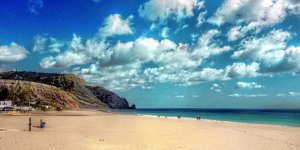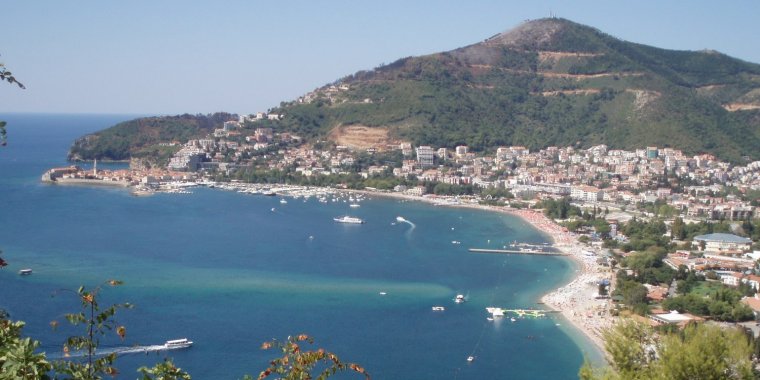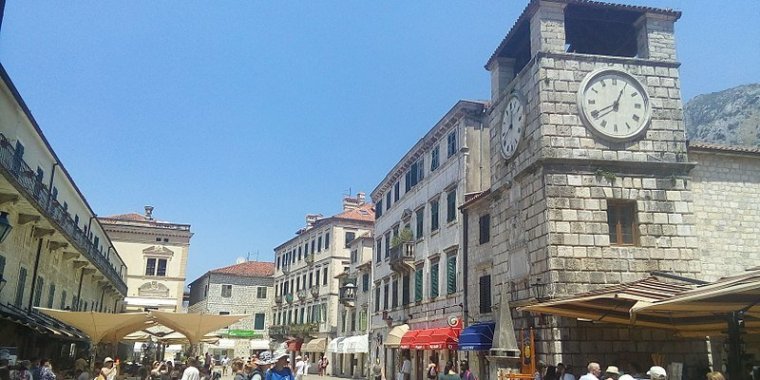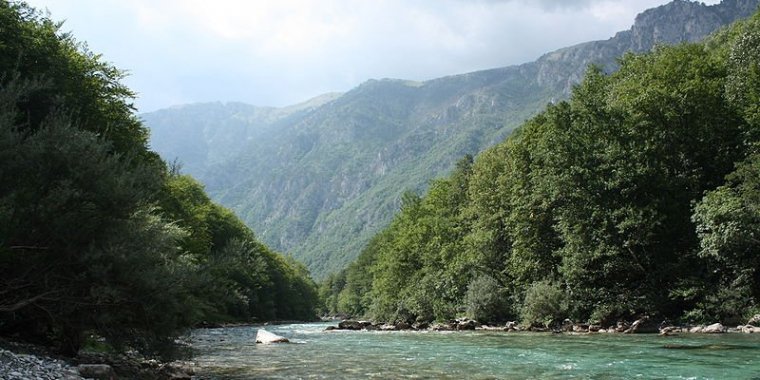| Travel / Destinations |
Montenegro
Montenegro (Crna Gora, Црна Гора) is a country in the Balkans, on the Adriatic Sea, home to 680,000 people. Montenegro has been a political entity since at least the 11th century.
For most of the 20th century, Montenegro was part of Yugoslavia, which started to break apart in the Yugoslav Wars in the 1990s. Montenegro remained united with Serbia until it became independent in 2006. It is one of Europe's youngest states.
Infrastructure greatly improved since independence as Montenegro became home to numerous five-star hotels, glamorous new settlements and investments in roads, energy, water and sanitary pipelines. Montenegro is divided into 21 municipalities, which can be grouped into five regions.
Cities
• Podgorica — the capital, and administrative centre as well as the biggest city in Montenegro, intensively developed since independence.
• Bar — the major port of the country.
• Budva — this fortified old town surrounded by high-rises, resorts and new developments is the most popular tourist spot with amazing beaches and wild nightlife.
• Cetinje — the old royal capital beneath Lovćen mountain and its national park features numerous museums, monasteries and former embassies.
• Kotor — an ancient fortified town deep down the Boka Kotorska bay, UNESCO World Heritage Site. It is a regular spot for cruiser ships.
• Nikšić — the second largest city in Montenegro and economically important, home to infamous Montenegrin beer Nikšićko.
• Tivat - a small town in the Bay of Kotor, quickly emerging into a major tourist, business and transport centre due to the 2nd international airport in the country.
• Žabljak — beneath Durmitor mountain and its national park is one of the key tourist destinations for both summer and winter activities.
• Ulcinj — an ancient fortified town, once the home of pirates, surrounded by a 12 km long sandy beach which is a kite-surfing hotspot, and naturist haven.
Other destinations
• Bečići — with a 2 km long fine sandy beach, it is home to many resorts and hotels.
• Biogradska Gora National Park — some of the last remaining untouched forests in Europe, and beautiful small lake where You can fish Yourself.
• Durmitor National Park — rafting through the Tara Canyon, the deepest canyon in Europe, is one of the most popular activities in Montenegro.
• Lovćen National Park — beautiful mountain with natural, cultural and historical scenery.
• Mount Ostrog — the amazing monastery situated on the almost vertical cliff of Mount Ostrog.
• Perast — beautiful small village, a UNESCO World Natural and Historical Heritage Site.
• Prokletije National Park - hiking and mountain climbing are this park's main attraction.
• Skadar Lake National Park — the largest lake on the Balkans and the natural habitat of the very diverse flora and fauna.
• Sveti Stefan — picturesque town-hotel, a former fishing town on the small peninsula near Budva.
Get in
Entry requirements. Holders of travel documents containing a valid Schengen visa, a valid visa of the United States of America or a permission to stay in these countries may enter and stay, i.e. pass through the territory of Montenegro up to seven days, and not longer than the expiry of visa if the period of validity of visa is less than seven days.
However, border guards are not fully aware of this information, and they might tell you that you require a visa to enter Montenegro. Stay calm and politely ask them to recheck their information.
As of Nov 2010, nationals of the following states may enter, pass through the territory of and stay in Montenegro up to 90 days with a valid travel document without a visa: Andorra, Argentina, Aruba, Australia, Austria, Belgium, Bermuda, Bosnia and Herzegovina, Brazil, Brunei, Bulgaria, Canada, Chile, Costa Rica, Croatia, Cyprus, Czech Republic, Denmark, Estonia, Finland, France, Germany, Guatemala, Greece, Holy See, Honduras, Hong Kong, Hungary, Iceland, Ireland, Israel, Italy, Japan, Republic of Korea, Latvia, Liechtenstein, Lithuania, Luxembourg, Macau, Macedonia, Malaysia, Malta, Mexico, Monaco, Nicaragua, Netherlands, Netherlands Antilles, New Zealand, Norway, Panama, Paraguay, Poland, Portugal, Romania, Russia, El Salvador, San Marino, Seychelles, Serbia, Singapore, Slovakia, Slovenia, Spain, Sweden, Switzerland, Taiwan, Turkey, United Kingdom, Uruguay, United States of America and Venezuela.
The exemption from the visa requirement also applies to the holders of valid travel documents issued by the Hong Kong Special Administrative Region of the People's Republic of China and the Macao Special Administrative Region of the People's Republic of China.
By plane. Podgorica airport (TGD). This is Montenegro's main international airport. It is 12 km (7.5 miles) south of Podgorica. It is a hub for Montenegro's national airline carrier, Montenegro Airlines.
One can get from the airport to Podgorica centre by taking the minibus, which usually waits in front of the terminal. The taxi to the centre will be more expensive, usually at €15. From the city centre (Republic Place) to the airport, a metered taxi costs €5-6.
There is no bus service from Podgorica airport to the coast. Hence, as soon as you exit the terminal, you will be surrounded by guys asking if you want a taxi. Hotels in Kotor will offer airport transfer for €70-80, so don't listen to guys quoting €120 or more for the drive to the coast. If you say "forget that", and take a taxi to the centre, they may try to bargain when you're in the car.
Tivat airport (TIV) (near the city of Tivat, on the Montenegin coast). This airport has regular flights to Belgrade throughout the year, and has charter flights to major European destinations during the summer. Tivat airport is 20 km from Budva and Herceg-Novi and 60 km from Bar.
Dubrovnik airport in Croatia is a half-hour drive from the Montenegro border and the coastal city of Herceg-Novi, and is served by many major airlines, so it is a good option for tourists coming by plane.
By train. There are one daytime and one overnight train (two in summer) from Belgrade. Trains go through Bijelo Polje, Kolašin, Podgorica and ends in Bar, Montenegro's main seaport. The railway through the Dinaric Mountains is considered as one of the most scenic railways in Europe. Travel by train is the cheapest way to get to Montenegro, but the quality of service is not very good. Trip time is 10 hr from Belgrade to Podgorica (11 hr to Bar), but expect considerable delays.
Ticket from Belgrade to Podgorica costs €19.20, plus €3 compulsory seat reservation or €6 berth reservation.
By bus. Montenegro is well connected with neighbouring countries and ticket prices are all under €25. During the summer, more seasonal lines are being introduced.
By car. European routes E65, E80, E762, E763 and E851 pass through the country, connecting it to Croatia, Bosnia and Herzegovina, Serbia, Kosovo and Albania.
There are no roads in Montenegro built to full motorway standard, as all roads are of single carriageway type. Almost all roads in Montenegro are curvy, mountainous roads, and speeds over 80 km/h are not permitted. The general speed limit within a built-up area is 50 km/h. Roads in the northern mountainous region require additional caution during the winter.
Driving with headlights is obligatory, even during the daytime; so is the use of seat belts.
By ship. There is a regular ferry line from Bar to Bari in Italy. The Bar-Bari line operates throughout the year, with service several times weekly during the summer. A trip to Bari takes around 8 hours. There is also ferry service from Bari, Italy, to Dubrovnik in Croatia. From there, bus service is available to Montenegro - the Dubrovnik bus station is adjacent to the port where the ferry docks.
Get around
By train. There is local train service, operating from Bar, through Podgorica and Kolasin and Mojkovac to Bijelo Polje. It is the cheapest way to travel from north to south and vice versa, the quality of service is not on the high level. Montenegro Railways also reactivated the train route to Niksic, providing a scenic and pretty cheap journey, without being slower than the bus.
By bus. This may be the easiest way to get around Montenegro. Buses are frequent (especially during the summer), safe and are more or less on schedule. Ticket prices within Montenegro are all under €15. Podgorica-Ulcinj €6, Podgorica-Cetinje €3,Cetinje-Kotor €5. Local buses usually have no airconditioning.
Besides the buses, there are minibuses at bus stations that are usually slightly cheaper, but are actually a faster and more comfortable option.
By car. As there is no real highway in Montenegro; most roads are two-lane only, with frequent addition of a third overtaking lane, and generally are not up to European standards. Most roads are curvy and mountainous, so speeds over 80 km/h (50 mph) are rarely legal, and rarely safe.
The speed limit is 80 km/h (50 mph) on the open road, unless signs specify otherwise. The speed limit inside the cities is 50 km/h (31 mph).
The use of safety belts and headlights during the day is compulsory, and the use of cellphones while driving is prohibited. Signposts used in Montenegro are almost identical to those used in EU countries.
Local drivers tend to drive fast, and to get involved into dangerous overtakings. Traffic jams are common during the peak of the summer season. Pedestrians are noutorious for jaywalking in every Montenegrin city.
Drivers tend to be extremely vocal, so don't take it personally if a driver yells at you.
Specific roads. Roads from Podgorica to Bar and to Niksic are fairly good and easy to drive on.
The roads from Podgorica through Cetinje to Budva and to Petrovac are both in good condition, but are curvy mountainous roads which rarely permit speeds over 70 km/h.
The road from Podgorica north to Kolasin, and then on to Zabljak or Serbia, is considered dangerous during the winter, especially the part through the Moraca canyon. It is recommended that one takes the bus to the north during the cold or rainy days, as bus drivers are experienced and know the road.
The old road from Cetinje to Kotor is mostly a narrow one-lane road offering stunning views of Kotor from above, but exercise extreme caution when passing on-coming traffic, over-taking and around corners.
By rental car. Rent-a-car business are numerous and prices start from 20 EUR per day for Toyota Yaris.
By thumb. Hitchhiking works pretty well in Montenegro, although the general warnings apply.
By helicopter. A unique opportunity to discover the wild beauty of Montenegro is also by helicopter. Transportation could be organised from Dubrovnik, Kotor, Budva, Podgorica. Well-established operators are specialized in scenic flights, charters and commercial transfers across the region.
See
Montenegro may be small in terms of area, it boast stunning mountainous landscapes, dramatic coast lines, historic monuments and truly beautiful walled towns. The Montenegro coast is just as gorgeous as that of its better known neighbour, Croatia, and it is for good reason that its main tourist destinations can get crowded in summer.
Nevertheless, if you can't visit at another time, don't let their popularity hold you back. Even the largest of cruise ship crowds will not stop you from enjoying this country's magnificent Riviera and Medieval coast towns, especially if you're willing to get up early and do your sightseeing ahead of the others.
Of the country's many churches and monasteries, the Serbian Orthodox Ostrog Monastery deserves special attention. It's spectacularly located against a practically vertical background, some 15 km from Nikšić. Founded in the 17th century, it's one of the most visited pilgrimage destinations on the Balkans and boasts a magnificent view over the Bjelopavlići plain.
The Riviera
The Bay of Kotor, is probably one of the prettiest bays in the world. On its deepest point lies the equally stunning town of Kotor, a beautifully preserved fortified, Medieval town with a vibrant history. Wandering through its labyrinth of narrow and cobblestoned streets, you'll come across lively piazzas, many ancient churches and lots of pleasant bars and restaurants.
Don't miss the 12th century St. Tryphon Cathedral, the Church of St. Luke and the Orthodox St Nicholas Church. Kotor is locked between the blue sea on one side, and a dramatically steep cliff on the other. It's a heavy walk uphill, but climbing the 1500 steps will allow you to see the old fortifications on the top as well as provide some amazing views over the bay.
Budva is the country's most popular tourist destination and boast some great beaches as well as a lovely, walled town centre. The old town centre is picturesquely located on a rather small peninsula, and its narrow, winding lanes hide a multitude of historic buildings, churches and small squares.
Among the most interesting monuments here are the 7th-century St. John's Church, the 8th-century Santa Marija of Punta and the 12th-century Church of St. Sava. The medieval town fortress is referred to as Citadela and right next to it is the colourful Church of the Holy Trinity, built in 1804.
Budva's over 30 km long Riviera has been called "The Riviera of Sandy Beaches" and is dotted with lovely hamlets and a wealth of historic monuments. A strip of hotels and restaurants separates it from the impressive mountain massifs of Lovcen. From Budva, it's an easy bus ride to the unique Sveti Stefan resort.
The small but gorgeous town of Perast saw some of its best architecture arise in the 17th and 18th century, when it belonged to the Republic of Venice. That typically Venetian, baroque architecture has been wonderfully preserved, with highlights including the Bujovic, Zmajevic, Badovic and Smekja Palaces which were once owned by wealthy maritime captains.
All the way in the south, Ulcinj is one of the Adriatic's oldest towns, with a delightful centre and lots of natural beauty around. It also makes a good base from where to explore the old centre of nearby Bar, Lake Skadar or even a cross border visit to Albania.
Although less spectacular than nearby Kotor, Herceg Novi (roughly translated as New Castle) is another charming Montenegrin town with a beautiful old centre and a good number of interesting churches, squares and fortresses.
Natural attractions
Although Montenegro's magnificent sea side scenery is best known among travellers, it's mountainous inland has some grand panoramic views to offer, too. The country shares the large freshwater Lake Skadar with neighbouring Albania. It has National Park status and offers great opportunities for hiking, bird watching and wildlife spotting. Of the many friendly fishermen's towns around it, Virpazar is the most convenient one for travellers.
A real must-see is the splendid Tara River Canyon, with its steep banks rising up to 1300 meters above the River Tara waters. It's the second longest canyon in the world and a UNESCO World Heritage Site. The canyon is located in Durmitor National Park, which is a World Heritage Site of its own and boasts a rich flora and fauna as well as snow-covered high peaks, several canyons and many glacier lakes.
The most visited one is Black Lake, at walking distance of the town of Žabljak, which serves as a traveller's hub for mountain and winter tourism.
Do
Festivals
Montenegro has a lot of local festivals that are worth going to and may range from typical music concerts to local festivities involving free food and drinks. Usually wine and seafood.
• Bokeška Noć (3rd week of August) - Celebrations under masks by the iconic fortifications of Kotor where each year a hateful figure is burned, and celebrations out in the open continues till early morning.
• Sea Dance Festival (end of July) - infamous Exit festival has found a new home for summer season and the biggest music happening in SE Europe is hosted on Jaz beach in Budva.
• Days of Wine and Fish in Virpazar - worth experiencing. Gathering of wine and fish lovers in a scenic local village on the Skadar Lake. Very crowded, and smokey from fish frying.
• Petrovačka noć (Petrovac) - celebrating the local traditions it is great time to visit the city and enjoy the crowd, food and music.
• Spring Break - typical music festival with plenty of DJs on Kamenovo beach.
• Blueberry Days - located in Plav in northern Montenegro this festival is attributed to blueberries which are infamous is important gathering of Montenegrin diaspora and its relatives as well as many tourists.
Outdoor activities
• Rafting. Rafting on archaic wooden or rubber boats down the 100km path of largest canyon in Europe is one-of-a-kind experience.
• Hiking/Trekking/Biking. Considering the size and very late development of infrastructure Montenegro has relied on various pathways interconnecting villages, roads, churches and mountains which is nowadays maintained and ideal for all outdoor activities. Maps of routs may be obtained by tourist offices located in towns.
• Cruise and dive in the Bay of Kotor. Iconic scenery of Boka Kotorska may be only appreciated fully from the sea-level and various small islands with tremendous history can only be reached that way. Diving may be interesting on several spots along Lustica.
• Paragliding over Budva Riviera. Scenery of Boka Bay may be only appreciated fully from the sea-level and various small islands with tremendous history can only be reached that way. Diving may be interesting on several spots along Lustica.
• Kite-surfing on the Ada Bojana. Experience winds on southern-most tip of Montenegros 12-km long sandy beach near Ulcinj.
• Skiing/Snowboarding. While during winter downhill skiing and snowboarding is usual activities within resorts in Žabljak and Kolašin throughout summer on many mountains specific regions remain under snow and are ideal for wild summer skiing/snowboarding experience.
Buy
Montenegro uses the euro, like several other European countries. One euro is divided into 100 cents. The official symbol for the euro is €, and its ISO code is EUR. There is no official symbol for the cent.
All banknotes and coins of this common currency are legal tender within all the countries, except that low-denomination coins (one and two cent) are phased out in some of them. The banknotes look the same across countries, while coins have a standard common design on one side and a national country-specific design on the other. The latter side is also used for different designs of commemorative coins. The design on the national side does not affect the use of the coin.
Business hours
Regular businesses and governmental agencies work from 08:00-09:00 to 16:00-17:00, while convenience stores, pharmacies and shops usually work until 20:00-21:00. Bars, pubs and restaurants usually work until midnight or 01:00 while clubs may run until 03:00 or 04:00.
Local specialities
• Cheese
• Smoked ham
• Traditional clothes
• Souvenirs
Clothes and shoes
City stores
• City centre and Bulevar Džordža Vašingtona in Podgorica
• Porto Montenegro
• many shops in Old Towns of Kotor and Budva
Shopping malls
• Delta City in Podgorica
• TQ Centre in Budva
• Kamelija in Kotor
Convenience shops & supermarkets
Voli markets, HD Laković, Maxi Markets and Roda are main retail supermarket chains and are found in almost all cities. There are also other convenience stores that stuff various goods. The prices of basic local food (baked goods, dairy products, fresh fruit and vegetables) are on the level of Bosnia and Serbia, i.e. generally cheaper than EU countries.
Eat and drink
In addition to the standard European and Mediterranean cuisine, Montenegro offers a variety of healthy food products and local specialities.
Cold hors-d'oeuvres include the famous njeguški pršut (smoked ham) and njeguški cheese, pljevaljski cheese, mushrooms, donuts and dried bleak. The main courses specific for the northern mountainous region are boiled lamb, lamb cooked in milk, cicvara in fresh milk cream (buttered corn porridge), boiled potatoes with cheese and fresh cream. A selection of traditional recipes of the central and coastal parts will include the kastradina (dried mutton), smoked and fresh carp (from Skadar lake) and a variety of fresh sea fish and seafood dishes. Donuts served with honey and dried figs are traditional desserts in these parts of Montenegro.
The best known Montenegrin wines are the premium whites: "Krstač", "Cabernet", "Chardonnay" and reds: "Vranac", "Pro Corde". All of them are produced by the famous company "Plantaže", but there's also some home-made wines of high quality, like Crmničko wine.
1L bottle of "Vranac" red wine will cost you from €8 to €15 in the bar or restaurant and it is well worth it! Also, you can buy a bottle of "Plantaze"'s wine for about €2-4 in supermarkets.
Also, Montenegro has boutique wineries as Knezevic from Golubovci and famous brand "Monte Grande" became signature wine of the country.
The continental region and north are more oriented towards the production of aromatic fruit flavoured brandy (plum brandy - šljivovica, apple brandy - jabukovača). Grape brandy "Montenegrin loza", "Prvijenac", "Kruna" or home made grape brandy (lozova rakija, lozovača) is a must-try, and a good choice to "warm up" before going out in the evening.
"Nikšićko" beer is the best known beer in the Montenegro, and most common alcoholic beverage, which cost from €0.50 to €2.50. It is produced as a draught beer, or bottled, in both "Nik Gold" and lighter "Nik Cool" variant. The dark variant, "Nik tamno", is praised among beer lovers.
Stay safe
Montenegro is generally a safe country. The number is 122, as well as the international distress call 112. When travelling in the areas bordering Kosovo, it is recommended you keep to the main roads. Unexploded landmines may remain along the Kosovo border. You should also avoid areas where there is military activity.
In the resort towns such as Kotor, Budva, Sveti Stefan and Herceg Novi, beggars and pickpockets are not uncommon. As in many other European locations, beggars are part of organized crime groups. Do not give them money. Doing so may also make you a target for more aggressive approaches. Always carry your bags in the safest way, slung around your shoulder with the pouch in front (with your money carried under your clothing) where you can keep your arm or hand across it.
Sea urchins are small, globular, spiny sea creatures that cover much of the sea floor off the coast of Montenegro. This isn't a bad thing being as they only gather in super clear water. It's a good idea to wear sea socks or something to cover your feet while walking through the water. Also, if you snorkel, be careful and ensure you don't brush up against the ones on the sides of the rocks.
Montenegrins are not safe drivers. You will often feel as though you are competing for road space with aggressive drivers who have little regard for your or their own safety. Many people also break the speed limits. Some roads are really narrow. Consequently, the country has one of the highest rates of traffic accident fatalities in Europe.
There are two species of viper snakes in Montenegro, sarka and poskok. Both are small but very venomous, so be careful when you hike around, watch your steps and remember that they never attack people if they are not disturbed.
Respect
Short pants are usually not permitted inside public institutions (hospitals, etc.) Wear modest clothing when visiting monasteries and churches. At beaches, taking off the bottom piece of a swimsuit will likely create a stir and is generally reserved for designated nude beaches.
When toasting and clinging glasses, look the opposite person in the eyes or else it may be taken as a sign of disrespect.
Being visibly drunk is a sign of bad taste and character in Montenegro: you may be invited to drink gallons but you're expected to be able to hold it. People also usually prefer to sip their liquor instead of emptying it "bottoms-up" style. Be careful: rakija, a plum spirit, is probably going to be stronger than you expect. (Wikivoyage)
YOU MAY ALSO LIKE








